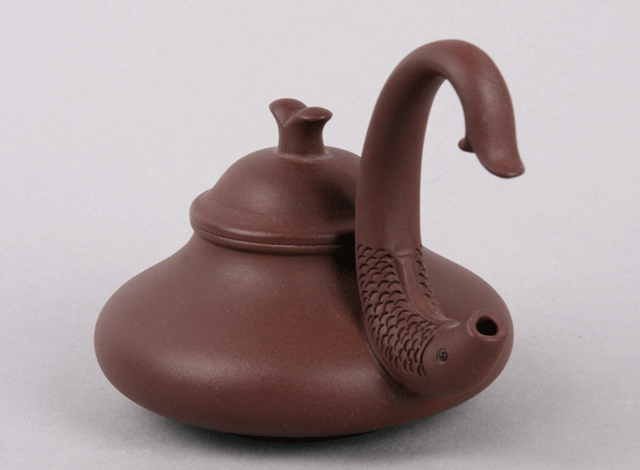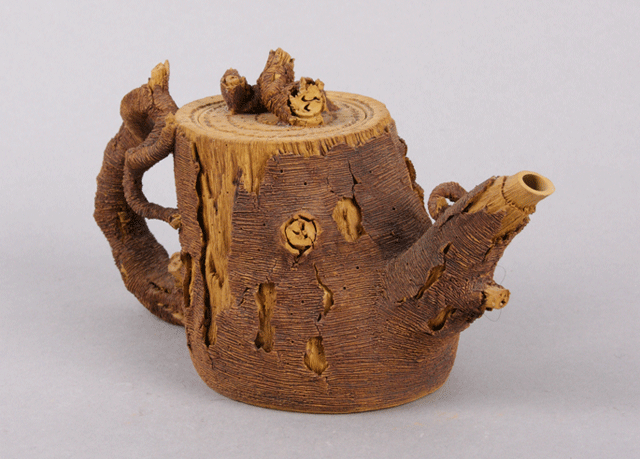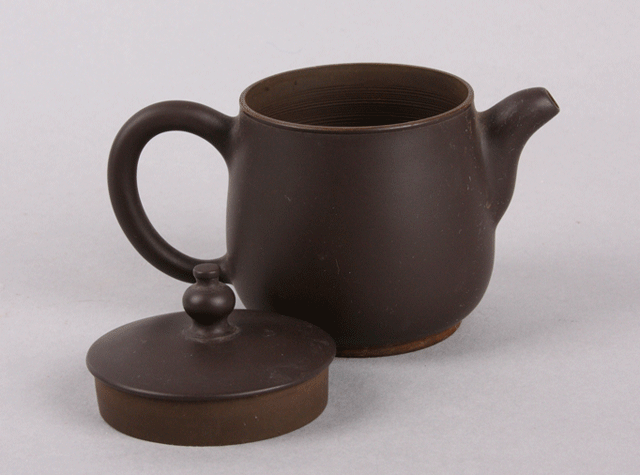
Yixing teapot; photo by B. Bernard.

Yixing teapot; photo by B. Bernard.
In the spring of 2014, John Cacciatore wrote:
Our adventure in China began when we were living in Los Angeles part time in 1999. We bought a couple of paintings from Rulan Geiger, a Chinese artist who married a California pilot. My wife, artist Nancy Kozikowski, had just curated The Thread of New Mexico (an exhibition of 30 New Mexico weavers for the Albuquerque Museum) and showed the catalog to Rulan. Rulan told her that the head of the Fiber Art department at TsingHua University in Beijing, Lin Le Cheng, was a good friend and she would be seeing him in Beijing the following month and would show him the catalog.
After Professor Lin saw the work of the New Mexico weavers he asked Nancy to help him put together an International Fiber Art Biennial. Nancy helped bring several New Mexico weavers to the show in China in 2000. She has been a participant and juror for the Lausanne to Beijing Fiber art Biennial every two years since.
In 2004 Nancy and I went to China three times, for about 2 months each time. I had always loved high quality Chinese tea and was excited to have so many places to get tea and tea pots right at the source. One district in western Beijing, Ma Lin Dao or Tea city, has many streets and alleys with shops offering every kind of tea and tea accessory from throughout China. I was in heaven and bought as much as I could.
On one trip we went to Xiamen, in Fujian Province, where there is a strong tea culture and much of the best tea in the world is grown. We lived with a host family and every day the gentleman of the house, who was an art dealer, wore a suit and tie and performed a Chinese Tea Ceremony for artists and art collectors who came to buy and sell paintings. I've owned an art gallery for several decades and thought, what a great system it was to combine the way of art with the way of tea. I began learning Chinese Tea Ceremony, called Gung Fu Cha, from him. We visited tea houses and tea farms where I purchased several kilograms of tea along with Yi Xing tea pots, tea tables and other Tea Ceremony accessories.
Chinese Tea Ceremony, Gung Fu Cha, literally means Hard Work Tea. The Yi Xing tea pots are small, the cups are small and the server is constantly filling the small tea pot with hot water, straining, and filling the three-sip cups for their guests. In my experience this delivers an exceptional cup of tea, drawing out sublime scents and flavors. As long as the guests empty the cups, the host keeps pouring. According to custom, when one is sated the cup should remain full. It indicates to the host that the guest has achieved abundance. This is why the ceremony is called hard work tea. In Chinese there is often a literal meaning and a poetic meaning. In this case the poetic meaning is Profound Effort Tea. Think of the times in our lives when we transform hard work into profound efforts, leading to superior results. Gung Fu Cha and Yi Xing pots are a poetic metaphor for profound efforts and superior results.
John Cacciatore and Nancy Kosikowsky live part of the year in Albuquerque and part of the year in an artists' colony outside Beijing. They own the Yixing (or Yi Xing) teapot show above, and the two additional examples shown below. For a second story about Yixing tea pots, please click here.

Yixing teapot; photo by B. Bernard.

Yixing teapot; photo by B. Bernard.
See source code for copyright information.
Page last revised on June 16, 2014.
Please report problems to toh@unm.edu